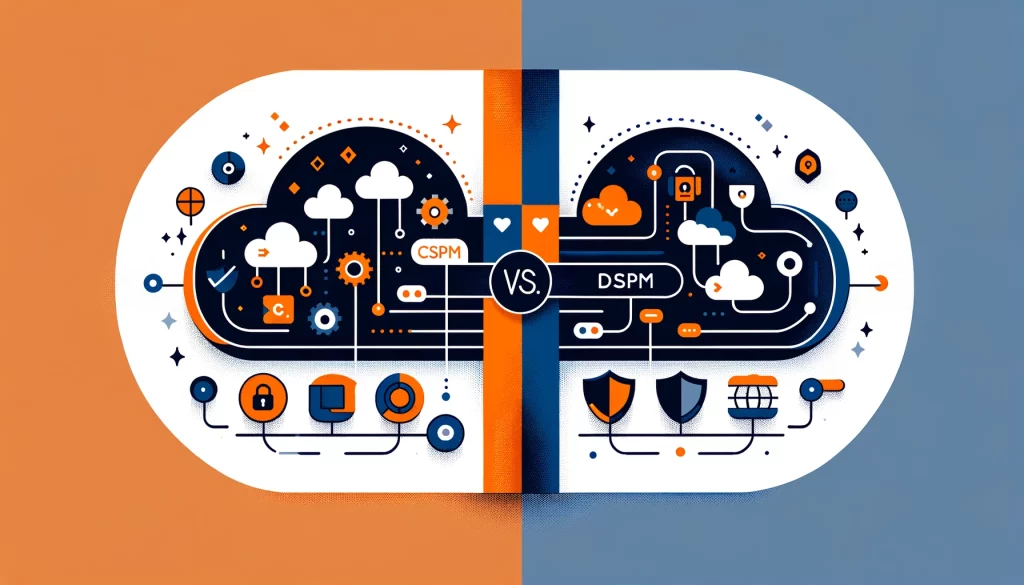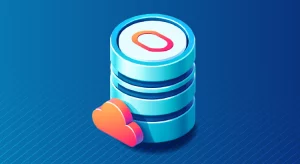
DSPM vs. CSPM

Organizations are increasingly embracing cloud computing to drive innovation and cost-efficiency. Moving to the cloud has brought new security challenges for businesses. They now need to protect both their cloud infrastructure and the sensitive data stored in it. Two main ways to address these challenges are Cloud Security Posture Management (CSPM) and Data Security Posture Management (DSPM).
This article will discuss the distinctions between CSPM and DSPM. It also covers their key characteristics and methods. Additionally, it will explore how these two can work in tandem to safeguard cloud infrastructure and data.
Understanding Cloud Security Posture Management
CSPM is a proactive approach to securing cloud infrastructure by monitoring and identifying errors, compliance issues, and potential weaknesses. CSPM helps security teams easily identify and address risks by providing a clear overview of security status across various cloud platforms.
Key Features of CSPM
Continuous Monitoring
One of the core features of CSPM is its ability to monitor cloud environments for potential security weaknesses. CSPM tools actively check cloud resources for errors and ensure proper configuration. This includes virtual machines, storage buckets, and networks. These tools do this regularly.
They ensure that they set up everything correctly and follow the recommended guidelines. This proactive approach helps organizations identify and address issues before malicious individuals can exploit them. This lowers the risk of data breaches and other security incidents.
Compliance Management
CSPM solutions play a crucial role in ensuring that cloud configurations align with industry standards and regulations. Different industries have specific rules to follow. For example, healthcare must follow HIPAA regulations. Payment card companies must adhere to PCI DSS guidelines. GDPR governs data privacy.
CSPM tools provide pre-built compliance templates and monitor cloud environments for any deviations from these standards. CSPM helps organizations stay compliant and avoid penalties by alerting security teams to issues in real-time.
Risk Assessment and Priorities
CSPM tools recognize that not all security risks are equal. They determine the level of risk by considering factors such as the sensitivity of the information. They assess the sensitivity of the information to determine the risk level. CSPM also evaluates the likelihood of misuse to gauge the level of risk.
The sensitivity of the information and the likelihood of misuse are key factors in assessing risk. By evaluating these factors, they can determine the level of risk associated with something. The sensitivity of the data refers to how important or confidential it is.
The likelihood of exploitation indicates the chance of someone misusing or compromising the data. By analyzing these factors, they can determine the level of risk associated with the data. CSPM helps organizations focus on fixing the most important risks by ranking them based on their potential impact. This risk-based approach ensures that we allocate resources effectively and address the most critical issues promptly.
The Importance of Data Security Posture Management
CSPM secures the cloud infrastructure, while DSPM protects the sensitive data inside. DSPM is a set of techniques and processes used to protect data. It ensures the security, privacy, and integrity of the data, which is the most valuable asset.
Key Techniques in DSPM
Data Discovery and Classifying
The first step in effective DSPM is identifying and classifying sensitive data across various systems and databases. This process uses tools to find and organize data based on its importance and impact on the business. Users use tools and techniques to determine the sensitivity of the data.
Businesses also use them to assess how the data affects the business. The team organizes the data accordingly. Organizations can protect sensitive data by knowing where it is and who needs access to it. This helps them prioritize which data needs the most protection.
Access Control and User Management
After identifying and classifying sensitive data, DSPM focuses on implementing strict access control policies to stop unauthorized access. RBAC and ABAC are models that control access to resources based on roles and attributes.
These models ensure that only authorized individuals can access specific resources. We grant access based on the roles and attributes assigned to each person. To prevent data breaches, organizations should limit employee access to necessary information. They should also take steps to prevent insider and hacker threats.
Data Encryption and Protection
Encrypting sensitive data, both at rest and in transit, is a fundamental aspect of DSPM. Organizations can keep their data safe from unauthorized access by using strong encryption and secure key management. This helps maintain privacy, even if someone steals the data. DSPM involves implementing additional measures such as DLP solutions to prevent unauthorized access to sensitive data.
CSPM vs. DSPM: Key Differences
CSPM and DSPM both aim to improve security, but they have different focuses and methods.
Scope of Protection
CSPM focuses primarily on securing the cloud infrastructure itself, ensuring that configurations align with best practices and compliance requirements. It deals with the security of the cloud environment, including virtual machines, storage buckets, and network settings. DSPM actively focuses on protecting sensitive data regardless of its storage location in the systems. DSPM ensures data security from creation to disposal, protecting it at every stage of its lifecycle.
Primary Objectives
The main goal of CSPM is to ensure the safety of the cloud environment and compliance with regulations. One can achieve it by identifying and correcting errors. It aims to stop attackers from using weaknesses in the cloud to access systems and data without permission. DSPM, in contrast, aims to safeguard sensitive data by implementing access controls, encryption, and other data protection measures.
Compliance Focus
Both CSPM and DSPM contribute to overall compliance efforts, but they focus on different aspects. CSPM focuses on making sure cloud configurations meet industry standards like HIPAA, PCI DSS, and GDPR.
It helps organizations demonstrate compliance by monitoring cloud environments for any deviations from these standards. DSPM is crucial for following rules and keeping data safe. It helps protect sensitive information and prevent data leaks.
CSPM vs. DSPM in Action
Let’s compare CSPM and DSPM by looking at a healthcare company. The company stores patient records in the cloud. They use on-site databases for research information. This will help us see the differences between the two approaches.
CSPM would make sure that the cloud infrastructure hosting patient records is secure and follows HIPAA rules. This involves monitoring the cloud environment for errors in settings, such as open ports or incorrect security groups. It also involves ensuring that we properly configure access controls.
DSPM, meanwhile, would focus on protecting sensitive patient information across both cloud and on-premises systems. This involves locating and arranging patient information. It also includes establishing clear guidelines for access to the information.
Additionally, you must ensure that you safeguard the data through encryption both during storage and transmission. DSPM would also involve implementing data loss prevention measures to detect and prevent the unauthorized exfiltration of patient data.
Implementing a Comprehensive Security Strategy
While CSPM and DSPM have distinct focuses, they are not mutually exclusive. In fact, organizations should implement both approaches to create a comprehensive security strategy that addresses both cloud infrastructure security and data protection.
Collaboration and Integration
Effective implementation of CSPM and DSPM requires collaboration among various teams, including security, IT, compliance, and business units. These teams must work together to identify sensitive data, define access policies, and implement security controls. Integration of CSPM and DSPM tools with existing security solutions, such as security information and event management (SIEM) and data loss prevention (DLP) systems, can provide a holistic view of an organization’s security posture and enable more effective incident response.
Continuous Monitoring and Improvement
Both CSPM and DSPM require ongoing monitoring and continuous improvement to stay ahead of evolving threats and changing regulations. An organization should conduct regular security assessments to identify gaps and weaknesses in its security posture. Important to have training and awareness programs for employees.
These programs help create a secure culture and ensure that everyone knows how to protect sensitive data. Organizations must regularly review and update policies and procedures to reflect changes in the threat landscape and regulatory environment.
Automation and AI
As the volume and complexity of data continue to grow, manual processes become increasingly challenging and time-consuming. Organizations can improve their security efforts by using AI and ML to automate CSPM and DSPM tasks.
This can also help them respond to threats faster. AI tools analyze large amounts of data to find problems and threats. ML algorithms can get better at detecting and responding to threats by learning from past incidents.
Conclusion
Cloud adoption and data generation are rapidly increasing, therefore organizations must prioritize both cloud infrastructure security and data protection. CSPM and DSPM offer complementary approaches to address these challenges, focusing on securing cloud environments and protecting sensitive information, respectively.
CSPM helps organizations maintain secure and compliant cloud infrastructure. It constantly checks for mistakes and weaknesses, ensuring they adhere to industry standards and best practices. DSPM protects sensitive data at all stages by using access controls, encryption, and data loss prevention measures.
By using both CSPM and DSPM, organizations can improve security, follow rules, and gain trust from customers. This helps prevent data breaches and keeps sensitive information safe. This requires collaboration among various teams, continuous monitoring and improvement, and the adoption of automation and AI technologies to scale security efforts.
To succeed, it’s important to be proactive and collaborate on security. This is crucial because threats and regulations are constantly changing. Working together can help ensure that your digital presence remains secure and compliant. Companies can build trust and grow by protecting their cloud infrastructure and data.
